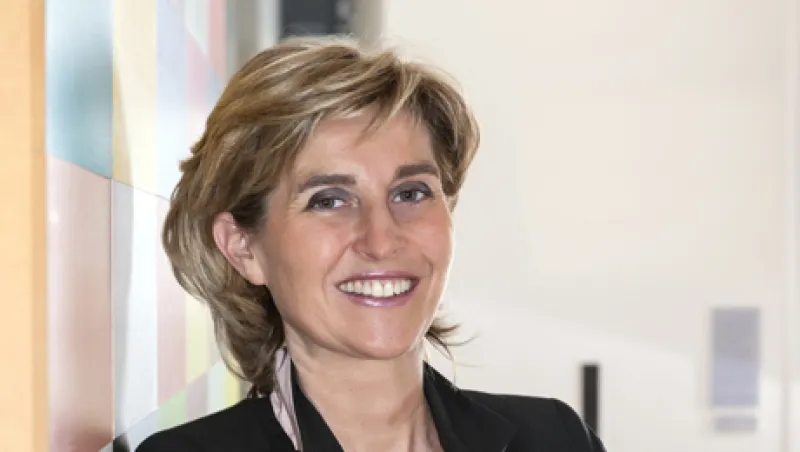Putting an investment banker at the head of an asset management firm is no guarantee of success. For every Jes Staley, who presided over a period of strong growth at J.P. Morgan Asset Management, there is a Peter Krauss, the former Goldman banker who has struggled to stem asset outflows at AllianceBernstein.
At Lyxor Asset Management, however, the logic of having a banker in charge is fairly compelling. The firm was born out of the powerful derivatives franchise of Société Générale, whose structured products proved so popular that the bank created Lyxor in 1998 to market them.
Lyxor’s popularity has flagged of late, however. The firm’s assets under management plunged by 25 percent in 2011, to $95.3 billion, reflecting a sharp setback in European markets and sizable asset outflows. So in March 2012 the bank replaced CEO Laurent Seyer with Inès de Dinechin, a derivatives specialist and former global head of fixed-income structured products.
De Dinechin has managed to stop the rot. AuM edged up to $99.4 billion at the end of 2012. Getting Lyxor back on the growth track will test her mettle, though. Recession and volatile markets in much of Europe, Lyxor’s core area, aren’t the most conducive environment. The showdown over Cyprus, where the government is frantically trying to negotiate a fresh bailout after lawmakers rejected a European Union package that would have raided bank deposits, only underscores the problem.
De Dinechin is confident that the European Central Bank has effectively eliminated the tail risk of a euro breakup, and that interest rates between core and peripheral countries will continue to narrow over the medium term. “Germany needs the euro. It’s a great advantage to them,” she says. But the bloc’s debt crisis is far from over, as the Cyprus situation demonstrates, and there are bound to be plenty of bumps along the way, she acknowledges.
So where does growth come from? One key priority is shoring up the firm’s exchange-trade funds business, which with $40.7 billion of assets is its biggest single product line. Lyxor, the No. 3 ETF player in Europe, along with No. 2 Deutsche Bank, risk being swamped by BlackRock and its iShares franchise. The U.S. giant will control nearly 50 percent of the European ETF market when it completes its acquisition of Credit Suisse’s ETF business, a deal it agreed in January.
That transaction spawned speculation that SocGen might unload its ETF business, but de Dinechin says she is determined to build the business. To that end, Lyxor has converted four of its European sovereign bond ETFs to physical products, which hold the underlying bonds in the product’s index. Previously, the firm sold only synthetic ETFs, which rely on derivatives to track the underlying market, but warnings by European regulators that synthetics could be a source of systemic risk have hurt the sector over the past two years. Physical ETFs, a segment that BlackRock dominates with a two-thirds market share, attracted the bulk of inflows into the European ETF sector last year.
“We want to be able to offer both” types of index funds, de Dinechin says. The firm will launch more physical ETFs in the fixed-income segment in the second quarter and plans to add equities as well. Still, the CEO remains committed to the firm’s existing lineup and believes the controversy over synthetics is dying down. Lyxor’s ETF inflows funds picked up late last year and have continued in 2013, she says. “I’m sure synthetic ETFs will come back.”
As for her giant rival, de Dinechin contends that its dominance may become a handicap. “BlackRock has probably reached a point where its size is an issue for clients,” she says. “That can be good for us.”
Elsewhere, de Dinechin is seeking to expand Lyxor’s presence in the U.S. alternatives market by targeting managed accounts. The firm manages just over $20 billion in alternatives and offers 120 funds on its platform. In the U.S., the CEO is putting the accent on 15 illiquid funds, primarily credit, multi-asset and CLO products. The U.S. is Lyxor’s No. 3 market, behind Asia, but “it has better growth potential than Asia,” she says.
Finally, de Dinechin wants to capitalize on Lyxor’s status as an arm of a big bank. Her next new thing is to develop liquidity products for the banking sector. Most banks need to build up their holdings of liquid securities to comply with the Basel III accord, which requires banks to hold enough cash and highly liquid securities to survive a 30-day stress scenario. Lyxor doesn’t have an off-the-shelf product yet, but it is working with some banks to develop a customized liquidity solutions; de Dinechin believes this could represent a €20 to €30 billion ($26 to $66 billion) opportunity.
“We are part of a bank so we really understand that issue.”






